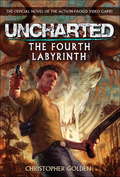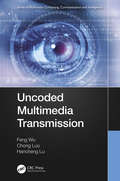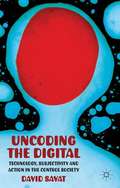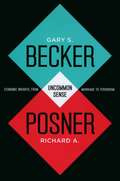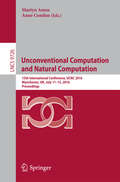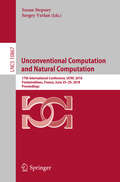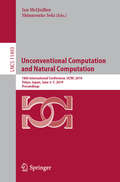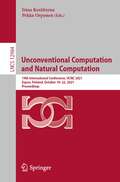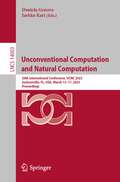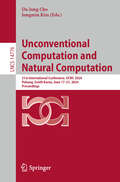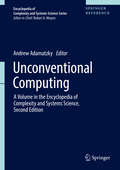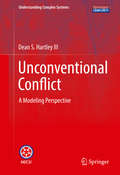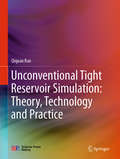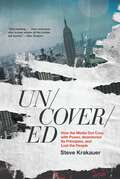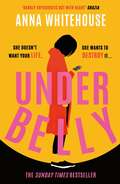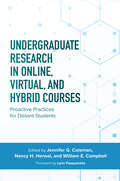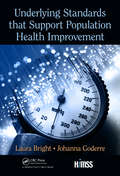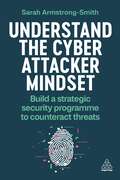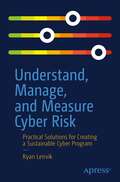- Table View
- List View
Uncharted: The Fourth Labyrinth
by Christopher GoldenThe official novel of Naughty Dog's award-winning videogame franchise! In the ancient world there was a myth about a king, a treasure, and a hellish labyrinth. Now the doors to that hell are open once again. Nathan Drake, treasure hunter and risk taker, has been called to New York City by the man who taught him everything about the "antiquities acquisition business." Victor Sullivan needs Drake's help. Sully's old friend, a world-famous archaeologist, has just been found murdered in Manhattan. Dodging assassins, Drake, Sully, and the dead man's daughter, Jada Hzujak, race from New York to underground excavations in Egypt and Greece. Their goal: to unravel an ancient myth of alchemy, look for three long-lost labyrinths, and find the astonishing discovery that got Jada's father killed. It appears that a fourth labyrinth was built in another land and another culture--and within it lies a key to unmatched wealth and power. An army of terrifying lost warriors guards this underground maze. So does a monster. And what lies beyond--if Drake can live long enough to reach it--is both a treasure and a poison, a paradise and a hell. Welcome to The Fourth Labyrinth.From the Trade Paperback edition.
Uncoded Multimedia Transmission (Multimedia Computing, Communication and Intelligence)
by Feng Wu Chong Luo Hancheng LuAn uncoded multimedia transmission (UMT) system is one that skips quantization and entropy coding in compression and all subsequent binary operations, including channel coding and bit-to-symbol mapping of modulation. By directly transmitting non-binary symbols with amplitude modulation, the uncoded system avoids the annoying cliff effect observed in the coded transmission system. This advantage makes uncoded transmission more suited to both unicast in varying channel conditions and multicast to heterogeneous users. Particularly, in the first part of Uncoded Multimedia Transmission, we consider how to improve the efficiency of uncoded transmission and make it on par with coded transmission. We then address issues and challenges regarding how to better utilize temporal and spatial correlation of images and video in the uncoded transmission, to achieve the optimal transmission performance. Next, we investigate the resource allocation problem for uncoded transmission, including subchannel, bandwidth and power allocation. By properly allocating these resources, uncoded transmission can achieve higher efficiency and more robust performance. Subsequently, we consider the image and video delivery in MIMO broadcasting networks with diverse channel quality and varying numbers of antennas across receivers. Finally, we investigate the cases where uncoded transmission can be used in conjunction with digital transmission for a balanced efficiency and adaptation capability. This book is the very first monograph in the general area of uncoded multimedia transmission written in a self-contained format. It addresses both the fundamentals and the applications of uncoded transmission. It gives a systematic introduction to the fundamental theory and concepts in this field, and at the same time, also presents specific applications that reveal the great potential and impacts for the technologies generated from the research in this field. By concentrating several important studies and developments currently taking place in the field of uncoded transmission in a single source, this book can reduce the time and cost required to learn and improve skills and knowledge in the field. The authors have been actively working in this field for years, and this book is the final essence of their years of long research in this field. The book may be used as a collection of research notes for researchers in this field, a reference book for practitioners or engineers, as well as a textbook for a graduate advanced seminar in this field or any related fields. The references collected in this book may be used as further reading lists or references for the readers.
Uncoding the Digital
by David SavatDigital media are having an enormous impact on the world. From the seemingly mundane, like playing World of Warcraft, to posting a message on Twitter or Facebook, to the operation of financial markets, to transformations in science and the economy - digital media continue to revolutionize how people live their daily life. This book challenges how we understand our relationship with our digital machines, and shows how they open up a new capacity for action in the world. A capacity for action that we should no longer simply think of in terms of movement and force, but also in terms of flow and viscosity. A capacity for action that produces a politics of fluids, and finds its expression not only in new forms of social control, but also in a renewed ability for people to engage with the world and each other.
Uncommon Sense: Economic Insights, from Marriage to Terrorism
by Richard A. Posner Gary S. BeckerA commentary on current events and economic issues, gathering the authors' most important and innovative entries.
Uncomputable: Play and Politics In the Long Digital Age
by Alexander GallowayA journey through the uncomputable remains of computer historyNarrating some lesser known episodes from the deep history of digital machines, Alexander R. Galloway explains the technology that drives the world today, and the fascinating people who brought these machines to life. With an eye to both the computable and the uncomputable, Galloway shows how computation emerges or fails to emerge, how the digital thrives but also atrophies, how networks interconnect while also fray and fall apart. By re-building obsolete technology using today's software, the past comes to light in new ways, from intricate algebraic patterns woven on a hand loom, to striking artificial-life simulations, to war games and back boxes. A description of the past, this book is also an assessment of all that remains uncomputable as we continue to live in the aftermath of the long digital age.
Unconventional Computation and Natural Computation
by Martyn Amos Anne CondonThis book constitutes the refereed proceedings of the 15th International Conference on Unconventional Computation and Natural Computation, UCNC 2016, held in Manchester, UK, in July 2016. The 15 revised full papers presented together with 5 invited papers were carefully reviewed and selected from 30 submissions. The papers cover a wide range of topics including molecular, cellular, quantum, optical and chaos computing; cellular automata; neural and evolutionary computation; artificial immune systems; Ant algorithms and swarm intelligence; amorphous computing; membrane computing; computational systems biology and computational neuroscience; and synthetic biology.
Unconventional Computation and Natural Computation
by Cristian S. Calude Michael J. DinneenThis book constitutes the refereed proceedings of the 14th International Conference on Unconventional Computation and Natural Computation, UCNC 2015, held in Auckland, New Zealand, in August/September 2015. The 16 revised full papers were carefully reviewed and selected from 38 submissions. The papers cover a wide range of topics including among others molecular (DNA) computing; quantum computing; optical computing; chaos computing; physarum computing; computation in hyperbolic spaces; collision-based computing; cellular automata; neural computation; evolutionary computation; swarm intelligence; nature-inspired algorithms; artificial immune systems; artificial life; membrane computing; amorphous computing; computational systems biology; genetic networks; protein-protein networks; transport networks; synthetic biology; cellular (in vivo) computing; and computations beyond the Turing model and philosophical aspects of computing.
Unconventional Computation and Natural Computation: 17th International Conference, UCNC 2018, Fontainebleau, France, June 25-29, 2018, Proceedings (Lecture Notes in Computer Science #10867)
by Susan Stepney Sergey VerlanThis book constitutes the proceedings of the 17th International Conference on Unconventional Computation and Natural Computation, UCNC 2018, held in Fontainebleau, France, in June 2018. The 15 full papers presented were carefully reviewed and selected from 22 submissions. The paper cover topics such as hypercomputation; chaos and dynamical systems based computing; granular, fuzzy and rough computing; mechanical computing; cellular, evolutionary, molecular, neural, and quantum computing; membrane computing; amorphous computing, swarm intelligence; artificial immune systems; physics of computation; chemical computation; evolving hardware; the computational nature of self-assembly, developmental processes, bacterial communication, and brain processes.
Unconventional Computation and Natural Computation: 18th International Conference, UCNC 2019, Tokyo, Japan, June 3–7, 2019, Proceedings (Lecture Notes in Computer Science #11493)
by Shinnosuke Seki Ian McQuillanThis book constitutes the proceedings of the 18th International Conference on Unconventional Computation and Natural Computation, UCNC 2019, held in Tokyo, Japan, in June 2019.The 19 full papers presented were carefully reviewed and selected from 32 submissions. The papers cover topics such as hypercomputation; chaos and dynamical systems based computing; granular, fuzzy and rough computing; mechanical computing; cellular, evolutionary, molecular, neural, and quantum computing; membrane computing; amorphous computing, swarm intelligence; artificial immune systems; physics of computation; chemical computation; evolving hardware; the computational nature of self-assembly, developmental processes, bacterial communication, and brain processes.
Unconventional Computation and Natural Computation: 19th International Conference, UCNC 2021, Espoo, Finland, October 18–22, 2021, Proceedings (Lecture Notes in Computer Science #12984)
by Irina Kostitsyna Pekka OrponenThis book constitutes the proceedings of the 19th International Conference on Unconventional Computation and Natural Computation, UCNC 2021, held in Espoo, Finland, in October 2021. The 12 full papers presented were carefully reviewed and selected from 19 submissions. The UCNC conference series covers fundamental research into computation that goes beyond the standard Turing model, including both computational models and methods inspired by nature, and the computational characteristics natural processes.
Unconventional Computation and Natural Computation: 20th International Conference, UCNC 2023, Jacksonville, FL, USA, March 13–17, 2023, Proceedings (Lecture Notes in Computer Science #14003)
by Jarkko Kari Daniela GenovaThis book constitutes the proceedings of the 20th International Conference on Unconventional Computation and Natural Computation, UCNC 2023, held in Jacksonville, FL, USA, in March 13–17, 2023. The UCNC conference series covers fundamental research on computation beyond the standard Turing model, including computational models and methods inspired by nature, and the computational properties of natural processes.
Unconventional Computation and Natural Computation: 21st International Conference, UCNC 2024, Pohang, South Korea, June 17–21, 2024, Proceedings (Lecture Notes in Computer Science #14776)
by Da-Jung Cho Jongmin KimThis book constitutes the proceedings of the 21st International Conference on Unconventional Computation and Natural Computation, UCNC 2024, held in Pohang, South Korea, during June 17–21, 2024. The 19 full papers included in this book were carefully reviewed and selected from 27 submissions. Typical, but not exclusive, UCNC topics of interest include amorphous computing, cellular automata, chaos and dynamical systems-based computing, cellular, chemical, evolutionary, bacterial, molecular, neural and optical computing, collision-based computing, quantum computing, DNA computing, membrane computing, material computing and programmable matter, super-Turing computation, swarm intelligence, and other nature-inspired algorithms.
Unconventional Computing: A Volume in the Encyclopedia of Complexity and Systems Science, Second Edition (Encyclopedia of Complexity and Systems Science Series #22)
by Andrew AdamatzkyThis volume of the Encyclopedia of Complexity and Systems Science, Second Edition, is a unique collection of concise overviews of state-of-art, theoretical and experimental findings, prepared by the world leaders in unconventional computing. Topics covered include bacterial computing, artificial chemistry, amorphous computing, computing with Solitons, evolution in materio, immune computing, mechanical computing, molecular automata, membrane computing, bio-inspired metaheuristics, reversible computing, sound and music computing, enzyme-based computing, structural machines, reservoir computing, infinity computing, biomolecular data structures, slime mold computing, nanocomputers, analog computers, DNA computing, novel hardware, thermodynamics of computation, and quantum and optical computing. Topics added to the second edition include: social algorithms, unconventional computational problems, enzyme-based computing, inductive Turing machines, reservoir computing, Grossone Infinity computing, slime mould computing, biomolecular data structures, parallelization of bio-inspired unconventional computing, and photonic computing.Unconventional computing is a cross-breed of computer science, physics, mathematics, chemistry, electronic engineering, biology, materials science and nanotechnology. The aims are to uncover and exploit principles and mechanisms of information processing in, and functional properties of, physical, chemical and living systems, with the goal to develop efficient algorithms, design optimal architectures and manufacture working prototypes of future and emergent computing devices.
Unconventional Conflict: A Modeling Perspective (Understanding Complex Systems)
by Dean S. Hartley IIIThis book describes issues in modeling unconventional conflict and suggests a new way to do the modeling. It presents an ontology that describes the unconventional conflict domain, which allows for greater ease in modeling unconventional conflict. Supporting holistic modeling, which means that we can see the entire picture of what needs to be modeled, the ontology allows us to make informed decisions about what to model and what to omit. The unconventional conflict ontology also separates the things we understand best from the things we understand least. This separation means that we can perform verification, validation and accreditation (VV&A) more efficiently and can describe the competence of the model more accurately.However, before this message can be presented in its entirety the supporting body of knowledge has to be explored. For this reason, the book offers chapters that focus on the description of unconventional conflict and the analyses that have been performed, modeling, with a concentration on past efforts at modeling unconventional conflict, the precursors to the ontology, and VV&A. Unconventional conflict is a complex, messy thing. It normally involves multiple actors, with their own conflicting agendas and differing concepts of legitimate actions. This book will present a useful introduction for researchers and professionals within the field.
Unconventional Performance Oriented Power Transformers Design Methodologies (Synthesis Lectures on Electrical Engineering)
by Amr Adly Salwa Abd-El-HafizThis book aims to offer practical and efficient methodologies to identify the main power transformer leading design variables that guarantee meeting a set of required performance specifications. Target audience are senior electrical power engineering students as well as design office engineers working in power transformers manufacturing plants.
Unconventional Tight Reservoir Simulation: Theory, Technology and Practice
by Qiquan RanThis book systematically introduces readers to the simulation theory and techniques of multiple media for unconventional tight reservoirs. It summarizes the macro/microscopic heterogeneities; the features of multiscale multiple media; the characteristics of complex fluid properties; the occurrence state of continental tight oil and gas reservoirs in China; and the complex flow characteristics and coupled production mechanism under unconventional development patterns. It also discusses the simulation theory of multiple media for unconventional tight oil and gas reservoirs; mathematic model of flow through discontinuous multiple media; geological modeling of discrete multiscale multiple media; and the simulation of multiscale, multiphase flow regimes and multiple media. In addition to the practical application of simulation and software for unconventional tight oil and gas, it also explores the development trends and prospects of simulation technology. The book is of interest to scientific researchers and technicians engaged in the development of oil and gas reservoirs, and serves as a reference resource for advanced graduate students in fields related to petroleum.
Uncovered: How the Media Got Cozy with Power, Abandoned Its Principles, and Lost the People
by Steve KrakauerFrom the COVID lab leak theory to Hunter Biden's laptop to Jeffrey Epstein, media critic and former CNN producer Steve Krakauer spotlights the problems of a news industry filled with geographically isolated, introspection-free, egomaniacal journalists. In Uncovered, America&’s sharpest media critic, former CNN insider Steve Krakauer, reveals exactly what went wrong—and why the media went off the rails. The fourth estate is supposed to be a conduit to the people and a check on power. But instead, we have geographically isolated, introspection-free, cozy-with-power, egomaniacal journalists thirsty for elite approval. Krakauer dives deep into some of the most egregious examples of the elite censorship collusion racket, like how tech suppression and media fear led to the New York Post-Hunter Biden email debacle before the 2020 election. Krakauer takes readers inside CNN after the shock Trump election, inside the New York Times after the Tom Cotton op-ed backlash, inside ESPN after the shift away from sports-only coverage, and more. No one understands these problems (and people) better than Krakauer. He has spent years getting to know the most influential players in the industry and this fascinating book is what he&’s learned. But most importantly, Krakauer equips readers with the crucial tools to sniff out when the press is lying or misleading the people of America in the future—so together, we can bypass them altogether. "Steve Krakauer's new book, Uncovered, is vital reading. It's the best and most perceptive deep dive into legacy media bias out there, from someone who knows where all the bodies are buried." ― Ben Shapiro "One of the most insightful critiques that has been published on this topic in years." ― Glenn Greenwald
Under Surveillance: Being Watched in Modern America
by Randolph Lewis&“An engaging, alarming, and enlightening book, one that is certain to be among the most important books on surveillance in the twenty-first century.&” —Siva Vaidhyanathan, author of Antisocial Media Never before has so much been known about so many. CCTV cameras, TSA scanners, NSA databases, big data marketers, predator drones, &“stop and frisk&” tactics, Facebook algorithms, hidden spyware, and even old-fashioned nosy neighbors—surveillance has become so ubiquitous that we take its presence for granted. While many types of surveillance are pitched as ways to make us safer, almost no one has examined the unintended consequences of living under constant scrutiny and how it changes the way we think and feel about the world. In Under Surveillance, Randolph Lewis offers a highly original look at the emotional, ethical, and aesthetic challenges of living with surveillance in America since 9/11. Taking a broad and humanistic approach, Lewis explores the growth of surveillance in surprising places, such as childhood and nature. He traces the rise of businesses designed to provide surveillance and security, including those that cater to the Bible Belt&’s houses of worship. And he peers into the dark side of playful surveillance, such as eBay&’s online guide to &“Fun with Surveillance Gadgets.&” A worried but ultimately genial guide to this landscape, Lewis helps us see the hidden costs of living in a &“control society&” in which surveillance is deemed essential to governance and business alike. Written accessibly for a general audience, Under Surveillance prompts us to think deeply about what Lewis calls &“the soft tissue damage&” inflicted by the culture of surveillance. &“A sprightly tour down some of the surveillance society&’s most claustrophobic corridors.&” —Cory Doctorow, New York Times–bestselling author
Under Surveillance: Being Watched in Modern America
by Randolph Lewis&“An engaging, alarming, and enlightening book, one that is certain to be among the most important books on surveillance in the twenty-first century.&” —Siva Vaidhyanathan, author of Antisocial Media Never before has so much been known about so many. CCTV cameras, TSA scanners, NSA databases, big data marketers, predator drones, &“stop and frisk&” tactics, Facebook algorithms, hidden spyware, and even old-fashioned nosy neighbors—surveillance has become so ubiquitous that we take its presence for granted. While many types of surveillance are pitched as ways to make us safer, almost no one has examined the unintended consequences of living under constant scrutiny and how it changes the way we think and feel about the world. In Under Surveillance, Randolph Lewis offers a highly original look at the emotional, ethical, and aesthetic challenges of living with surveillance in America since 9/11. Taking a broad and humanistic approach, Lewis explores the growth of surveillance in surprising places, such as childhood and nature. He traces the rise of businesses designed to provide surveillance and security, including those that cater to the Bible Belt&’s houses of worship. And he peers into the dark side of playful surveillance, such as eBay&’s online guide to &“Fun with Surveillance Gadgets.&” A worried but ultimately genial guide to this landscape, Lewis helps us see the hidden costs of living in a &“control society&” in which surveillance is deemed essential to governance and business alike. Written accessibly for a general audience, Under Surveillance prompts us to think deeply about what Lewis calls &“the soft tissue damage&” inflicted by the culture of surveillance. &“A sprightly tour down some of the surveillance society&’s most claustrophobic corridors.&” —Cory Doctorow, New York Times–bestselling author
Underbelly: The instant Sunday Times bestseller from Mother Pukka – the unmissable, gripping and electrifying fiction debut for summer 2021
by Anna Whitehouse'Darkly voyeuristic but with heart - as funny as it is painful and true. We loved it' GRAZIA'I don't think I've ever turned the pages of a book so quickly. So sharp, so tender... truly excellent storytelling' DAISY BUCHANAN'Entertaining and playful but with huge depth, meaning and heart. I raced through it' EMMA GANNON'Thrilling, exhilarating, devastating. A must-read' LAURA JANE WILLIAMS'Engrossing, fantastically written and painfully real. I laughed, sobbed and got the chills' JESSICA RYNUNDERBELLY[n.] singular The soft underside or abdomen of a mammal. An area vulnerable to attack.A dark, hidden part of society.Lo and Dylan are living parallel lives, worlds apart. Lo is the ultimate middle-class mother, all perfectly polished Instagram posts and armchair activism. Dylan is just about surviving on a zero-hours telemarketing job from her flat, trying to keep food on the table.But when they meet at the school gates, they are catapulted into each other's homes and lives - with devastating consequences . . . Explosive, sharply humorous and unflinchingly honest, Underbelly slices through the filtered surface of modern women's lives to expose the dark truth beneath.Coming August 2021!Praise for Anna Whitehouse:'Painful and funny - and painfully funny' Emma Freud'Thank God there is none of that smug, married-couple twattery in this book. I loved it' Jane Garvey'Fantastically unsmug' Woman's Hour'This book is a hoot - hilarious and heartfelt' Emma Gannon'Snort-tea-through-nose funny' Cherry Healey'This book left me laughing so very hard and equally blubbing with tears' Jools Oliver
Undergraduate Research in Online, Virtual, and Hybrid Courses: Proactive Practices for Distant Students
by Nancy H. Hensel Jennifer G. Coleman Wm. E. CampbellCo-published with and With the growing interest in undergraduate research as a high-impact practice, and the recognition that college education is increasingly moving online, this book – the first to do so – provides a framework, guidance from pioneering practitioners, and a range of examples across disciplines on how to engage remote students in research.Two foundational chapters set the scene. For those new to incorporating undergraduate research in their courses, the opening chapter provides an introduction to its evolution and practice, and reviews the evidence of its benefits for students, faculty, and institutions. The second addresses the benefit that undergraduate research can bring to online learning and provides an overview of the ways research can be incorporated into online and virtual courses to meet the course and student learning objectives. The remaining chapters illustrate implementation of undergraduate research in courses across many disciplines. They address thematic issues related to the work and its effects on students, such as transitioning them from users of, to active participants in, research; and consideration of the technological tools needed to support students in a virtual environment. The contributors, some of whom have been implementing these practices for some years, offer important insights and expertise.While the examples range across the behavioral sciences, business, education, the health professions, the humanities, social sciences, and STEM, readers will find much of value and inspiration from reading the chapters beyond their disciplines.
Underlying Standards that Support Population Health Improvement (HIMSS Book Series)
by Laura Bright Johanna GoderreThis book highlights success stories and challenges to implementing health IT standards. The narrative of each chapter demonstrates how standards further interoperable health data exchange, especially in the service of advancing tools to monitor population health. These are critical stories that demonstrate to an international community of health and IT experts how to bring the right stakeholders together and bridge classic divides between software architects and clinical end users, health system decision-makers and standard authors.
Understand the Cyber Attacker Mindset: Build a Strategic Security Programme to Counteract Threats
by Sarah Armstrong-SmithTo counteract a cyber attacker, organizations need to learn to think like one. Understand the Cyber Attacker Mindset explores the psychology of cyber warfare and how organizations can defend themselves against attacks. This book provides a comprehensive look at the inner workings of cyber attackers in the digital age and presents a set of strategies that organizations can deploy to counteract them. With technological advancements in cybersecurity, attackers are increasingly falling back to social engineering and preying on people's vulnerabilities. This book examines different types of cyber attackers, explores their motivations, and examines the methods used. It also reviews key industry developments such as cybercrime as a service, brokers and syndicates, nation-sponsored actors, insider sabotage and the challenges faced by law enforcement in tracking and apprehending attackers. Understand the Cyber Attacker Mindset offers expert, strategic guidance on how organizations can improve their cybersecurity operations in response, including enhancing security awareness training, educating employees to identify and resist manipulation, understanding the importance of cultural variances and how board-level decision-making can directly influence attacks. Written by a renowned cybersecurity leader, the book draws on interviews with ex-criminals and top experts in the field to share rich insights and a wide range of case studies profiling notable groups, such as Anonymous, Lapsus$, FIN7, Nigeria's Yahoo Boys, Sandworm, and the Lazarus Group. The human side of cybersecurity has never been so important.
Understand, Manage, and Measure Cyber Risk: Practical Solutions for Creating a Sustainable Cyber Program
by Ryan LeirvikWhen it comes to managing cybersecurity in an organization, most organizations tussle with basic foundational components. This practitioner’s guide lays down those foundational components, with real client examples and pitfalls to avoid. A plethora of cybersecurity management resources are available—many with sound advice, management approaches, and technical solutions—but few with one common theme that pulls together management and technology, with a focus on executive oversight. Author Ryan Leirvik helps solve these common problems by providing a clear, easy-to-understand, and easy-to-deploy foundational cyber risk management approach applicable to your entire organization.The book provides tools and methods in a straight-forward practical manner to guide the management of your cybersecurity program and helps practitioners pull cyber from a “technical” problem to a “business risk management” problem, equipping you with a simple approach to understand, manage, and measure cyber risk for your enterprise. What You Will Learn Educate the executives/board on what you are doing to reduce riskCommunicate the value of cybersecurity programs and investments through insightful risk-informative metricsKnow your key performance indicators (KPIs), key risk indicators (KRIs), and/or objectives and key resultsPrioritize appropriate resources through identifying program-related gapsLay down the foundational components of a program based on real examples, including pitfalls to avoid Who This Book Is For CISOs, CROs, CIOs, directors of risk management, and anyone struggling to pull together frameworks or basic metrics to quantify uncertainty and address risk
